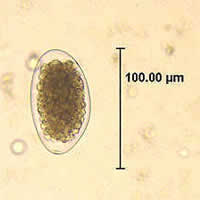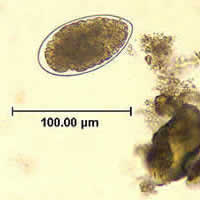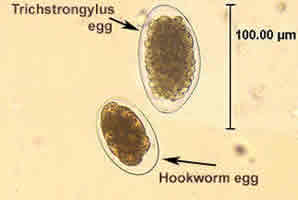
Monthy Case Studies - 2000
Case #45 - October, 2000
A middle-aged couple from Delaware had taken a ten-day Middle Eastern vacation in Iran, Iraq, Jordan, and Egypt. Three months after their return, the couple was scheduled for routine annual physicals. The woman told the nurse that she had been experiencing intermittent mild abdominal cramping and occasional loose stools. Her husband was not sick. Stool specimens were collected from the couple as part of the physical examination, along with other tests such as blood chemistries, EKG, and so on. The objects in Figures A and B were found in both stool specimens after an FEA (formalin-ethyl acetate) concentration procedure. What is your diagnosis? Based on what criteria?

Figure A

Figure B
Answer to Case #45
This was a case of trichostrongylosis caused by Trichostrongylus sp. Diagnostic features observed were:
- Sthe size of the eggs (Trichostrongylus species eggs measure 75 to 100 micrometers in length by 40 to 55 micrometers in width).
- the presence of a thin shell.
- the shape of the eggs (Trichostrongylus sp. eggs are oval with one or, in some cases, both ends somewhat tapered).
- the morphology of developing ovum (Trichostrongylus sp. eggs, when found in the stool, are usually in an advanced cleavage, or morula, stage of development).
The eggs of Trichostrongylus sp. can be easily confused with hookworm eggs. Hookworm eggs have a thin shell and can have advanced cleavage when found in stool, but they are smaller, measuring only 60 to 75 micrometers by 36 to 40 micrometers, and normally do not have a tapered end. We have made a composite image (Figure A below) to demonstrate the differences between hookworm and Trichostrongylus sp. eggs.

Figure C
More on: Trichostrongylosis
Images presented in the monthly case studies are from specimens submitted for diagnosis or archiving. On rare occasions, clinical histories given may be partly fictitious.
 ShareCompartir
ShareCompartir


